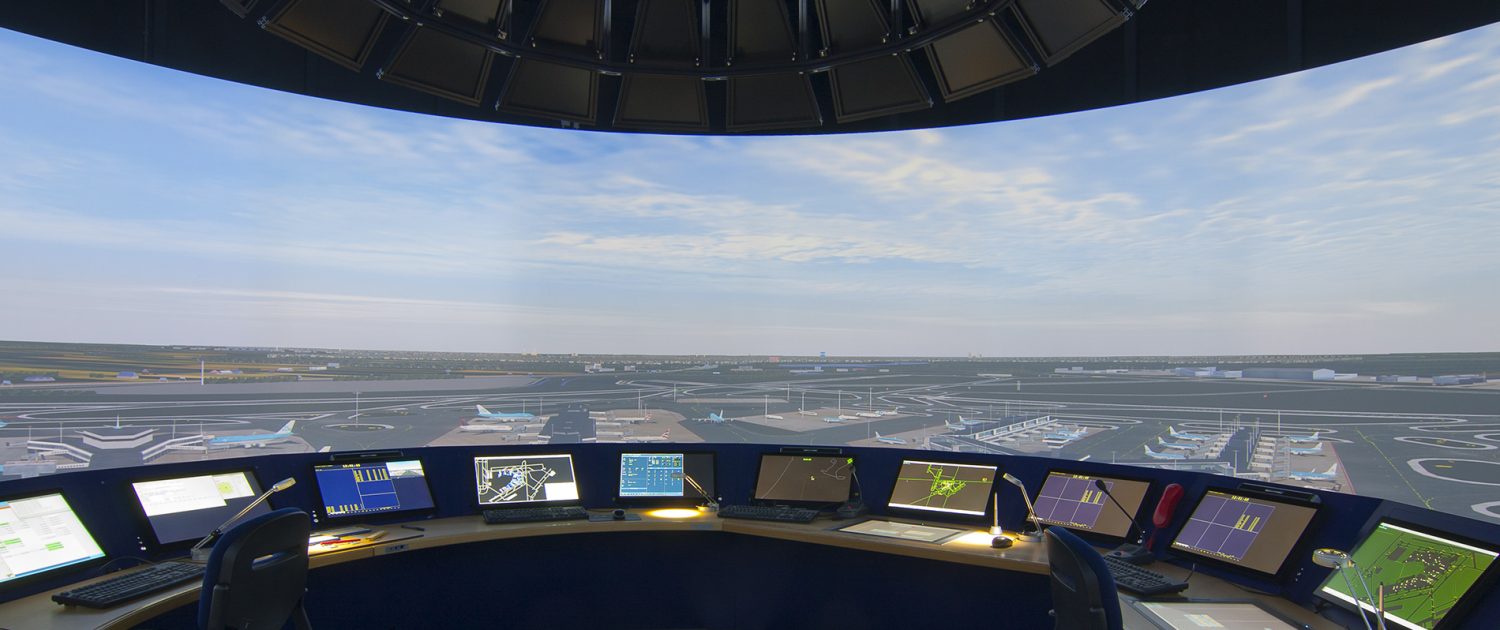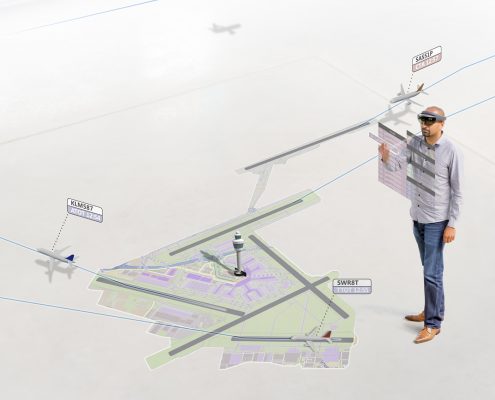Tucked away in the striking head office of the Netherlands Aerospace Centre (NLR) in Amsterdam we find the real-time Air Traffic Control (ATC) research simulators NARSIM Radar and NARSIM Tower, as well as a testing facility for remote towers. Together, they constitute a versatile research and training facility for ‘human-in-the-loop’ experiments. At NLR, new concepts can be developed, assessed and validated using fast prototyping, also because the system has been entirely developed in-house.
To find out more about the day-to-day work performed at these research and training facilities, we talked to Roland Vercammen, head of NLR’s Air Traffic Management & Airports department, Marcel van Apeldoorn, developer and head of NLR’s Air Traffic Control Research Simulator facility (NARSIM) and Bern Stegeman, R&D Engineer at NLR and currently seconded to Air Traffic Control the Netherlands (Luchtverkeersleiding Nederland, LVNL) at Schiphol Airport. Secondment is an important aspect of NLR’s work: it allows the centre to closely monitor developments in the field so it can address existing and future challenges as effectively as possible.
The NARSIM simulators originate in a collaboration with LVNL that began some 30 years ago. This ensures that NLR can draw on extensive experience and enables the NARSIM team – which currently consists of five full-time employees – to remain at the forefront of ATC-related innovations. In addition, a NARSIM community has been created because the system is used worldwide in countries including Germany, Singapore and Sweden. All developments made by the parties involved can then be shared with the community, with due consideration of intellectual property rights. NLR and other community members subsequently apply this shared knowledge in their research and consultancy work for Air Navigation Service Providers (ANSPs) all over the world.
The NARSIM facility of NLR in Amsterdam
NARSIM
“NLR is directly involved in fundamental research, including in a pan-European context such as in the SESAR programme,” says Bern Stegeman. “We have the full package: a real-time simulator, fast-time simulation capabilities, and the expertise of our departments operating in related fields like safety, environmental protection, human factors and training. This makes our approach unique in the world
NLR’s Air Traffic Management & Airports department serves as a bridge between fundamental research and support for the organizations that provide air traffic control services 24 hours a day and seven days a week. Consequently, the staff members of this ATM department not only know a great deal about the latest research, but also about air traffic control. “We develop new concepts, algorithms and tools which are evaluated and assessed together with air traffic controllers and pilots. We also provide support for training courses to familiarize users with new concepts and systems.”
Vercammen mentions the importance of NARSIM for research projects: “There are not many research simulators of this kind worldwide, and NLR can test, assess and validate new tools and concepts using fast prototyping – all in collaboration with an active community.” Stegeman indicates that the simulations serve more than just theoretical purposes – colleagues using the research facility have developed versions of products themselves, such as an electronic flight strip system. “We know how controllers use such a system, and we are familiar with the entire process from development through to testing and roll-out. That truly provides added value,” says Stegeman. After a tool has been fully developed and successfully validated, the requirements are derived. “Based on those requirements, the industry can then implement the new tooling at ATC organizations,” says Vercammen. Stegeman: “We develop up to approximately Technology Readiness Level 6 or 7. For example, we worked on a runway incursion alerting system up to the prototype phase. That’s where our strength lies. We can develop a concept quickly; it has to be stable in operation and be testable. That’s the whole aim of the system: to develop new functionality in a relatively short period of time.”
NLR provides support for airspace optimization because it has in-house experts that can carry out macro-optimizations. “Such optimizations often yield various options. Our team includes researchers who are also pilots, and who can perform airspace tests of the various options using our own test aircraft or flght simulators,” says Vercammen.
Virtual Block Control
Van Apeldoorn provides two examples of how NARSIM is used in practice for a wide range of applications; from large-scale validation to prototyping and deriving specifications.
A recent study on the virtual stop bar concept is an example of a large-scale validation exercise using both NARSIM Tower and NLR’s own Flight Simulator called Grace. “The construction of stop bars on the taxiways of an airport is expensive,” says Van Apeldoorn, “but the costs can be significantly reduced by virtualizing them using advance surface movement guidance and control systems.” In poor visibility, air traffic controllers need to guide aircraft from stop bar to stop bar, which results in a disrupted operation. In this study, the researchers experimented with subdividing the blocks by adding virtual stop bars, which results in smoother traffic flows.
In addition to controllers, these experiments often also involve pilots by linking a flight simulator to NARSIM Tower. All these advanced simulations are then compared with baseline simulations, which are based on the standard operating procedures of controllers. One major benefit of conducting these experiments is that the test subjects are also subjected to measurements during the simulations. This may mean that subjects are asked to assess their perceived workload by pressing a button. Pupil diameter measurements and gaze tracking are also frequently used methods to determine workload or to see if and when air traffic controllers are actually using the new system by really looking at it.
Prototyping and deriving specifications: GARDS
New software can be easily integrated into NARSIM and then used to perform simulations. This is a very practical approach for research into situations that still require a solution. As an example, Van Apeldoorn mentions an early warning system that alerts traffic controllers when an aircraft performs a go-around. “In principle, pilots must notify air traffic control if they intend to perform a go-around, but they do not always do so on time,” says Van Apeldoorn. “So we wanted to know if we could develop a system that detects non-standard aircraft behaviour during the approach using specific algorithms.” For this purpose, an air traffic controller was asked to perform real-time human-in-the-loop simulations using NARSIM, to find out if the system provides alerts in time and does so correctly (to ensure that traffic controllers do not start ignoring the warnings). “We adjusted the algorithms during these simulations to find the correct balance between useful and false alerts through simulations, and the Go-Around Detection System (GARDS) was implemented at Schiphol Airport in 2016,” says Van Apeldoorn
Virtualization in Air Traffic Management
NLR has been researching the use of Augmented Reality (AR) and Virtual Reality (VR) for over 25 years, and began testing the application of AR techniques in control towers some 10 years ago. Augmented Reality involves adding data to existing relevant visual information. Research in this field is conducted for both civil and military applications, using Head-Mounted Displays (HMDs) and other devices. In NARSIM Tower, a HMD was used to add air traffic data and other information to the field of vision of the traffic controller. NLR is currently exploring the ways in which VR can be used by radar traffic controllers. Future generations of traffic controllers may use VR and AR applications as part of their day-to-day work.
According to Vercammen, AR can already fulfil an important role in remote towers, in particular because large amounts of information can be added to the out-of-the-window view. In the case of a remote tower, the out-of-the-window view based on camera images is already a digital image. Adding data to these images will help traffic controllers to improve situational awareness and reduce head-down time.
However, AR applications do give rise to new questions: Do users want to ‘see more’ electronically? Is it possible to have too much information? For instance, adding infrared camera images would mean that the traffic controller sees more than the pilot, who does not have access to such visual data. Will the inclusion of aircraft identification details and electronic flight strips in the out-of-the-window viewreduce the workload and improve safety? These are all questions that can be answered in the short term based on thorough research.
The use of AR and VR for air traffic control purposes is still in an experimental phase. New generations of controllers may grow up with AR and VR techniques and be completely familiar with them. Use of such technology in ATC applications will be routine for them. In the short term, Virtual Reality could be used to enhance the (three-dimensional) situational awareness of air traffic controllers in training, thus accelerating the training process. VR can also be used in airspace redesign projects to provide stakeholders with insight into design issues, restrictions, bottlenecks and solutions.




